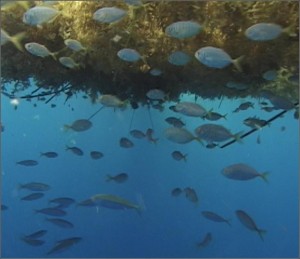Video: Our Role In Saving Sargasso Sea
 Bermuda and its surrounding waters lie within the Sargasso Sea, an enormous mass of water that is driven in a clockwise direction by strong ocean currents.
Bermuda and its surrounding waters lie within the Sargasso Sea, an enormous mass of water that is driven in a clockwise direction by strong ocean currents.
Floating on its surface are large mats of unique seaweed known as Sargassum [pictured], which support a unique variety of marine life. The seaweed — which washes ashore here during winter storms — plays a crucial role in the Atlantic eco-system.
Scientists have documented that eel species from European and North American rivers migrate here to spawn. Their young then make their way back to live in these rivers.
The Sargasso Sea also plays an important role in the life cycle of the porbeagle shark, which is considered “vulnerable” by the International Union for Conservation of Nature Red List of Threatened Species.
Recent research has found that the Sargasso Sea serves as critical birthing grounds for the shark species. Given this highly productive ecosystem, scientists, Bermudians and others are concerned about protecting this area from emerging threats, such as proposals to harvest Sargassum for biofuel.
Currently the international Pew Environment Group lobbying for a marine national park to be established off Bermuda which would protect the Sargasso Sea from commercial exploitation.
Local and international conservationists, teaming with the Bermuda Government, have joined the Pew initiative in an effort to have the Sargasso Sea protected by law.
Last year the Atlantic Conservation Partnership [ACP] — formerly Friends of the Bermuda Aquarium — commissioned a short film from Look Bermuda aimed at raising awareness about Bermuda’s role in the international campaign to preserve the Sargasso Sea.
Last May the film was screened at “Project Ocean Talks” sponsored by London retailer Selfridges and attended by international conservationists, legislators and government representatives, including Bermuda’s Director of Environmental Protection Dr. Fred Ming, who spoke at the event.
The six-minute short describes the eco-rich area in the middle of the North Atlantic west of Bermuda.
A longer film on Bermuda and the Sargasso Sea is currently being completed for use in the island’s schools.
Th ACP was launched in 1993 as a US public charity that permits tax deductible contributions for US donors consistent with Internal Revenue Service regulations.
The Bermuda Aquarium, Museum & Zoo [BAMZ] was established in 1926 by the Bermuda Government and has become a leader in environmental conservation, education and research through the efforts of its two support agencies, the local charity Bermuda Zoological Society [BZS] and the ACP.
- Video courtesy of Look Bermuda.
Read More About
Category: All, Environment, Videos


Congratulations to Atlantic Conservation Partnership and Look Bermuda. Great film! This will certainly help demonstrate the importance of protecting our Sargasso Sea. Hopefully it will also encourage Bermuda’s residents to be more tolerant of the seaweed on our beaches which play an important role.
For the first time ever, I collected seaweed a few weeks ago from Shelly Bay where there were huge piles of dried seaweed. Remembering when my elders collected the dried seaweed for their gardens, I thought that it was ok. I took mostly air/sun dried seaweed and checked carefully for any little sea creatures. Having seen the video, I will no longer harvest seaweed. The guys from Ag and Fish were raking it up off the beach. I asked if it was ok to take some and was told that they were going to take it up and use it for fertilizer at Botanical Gardens. I know that the south shore beaches are cleared of seaweed during the “tourist season” for appearances to appear to have clean beaches, but -without the seaweed, we will lose our beaches and have a negative impact on the ecology of Bermuda. I realize that the Sargassum sea is like a huge ocean nursery of many species. I’ll be glad to see the new video on the Sargassum sea and learn about it’s function in the ocean and the residents.
I’m hoping that everyone gets the message and repatriates seaweed back. Had I known, I would have put it back, but most of it went into the garden and it would be damaging to do so because returning the seaweed with the soil (even little bits) would cause more damage. My apologies to our island home. Lesson learned.
I am definately against harvesting sargassum seaweed for use as Bio Fuel since what I’ve learned.We have a responsibility to Bermuda. Please show this document on local TV to educate our population.
YES GO BERMY!! :}
This is truly a very educational film and should definitely be shown in schools. I have known that Bermudians have for years used the seaweed for their gardens without really knowing the importance of leaving it be. Just like the conch’s and other things are against the law to remove this should also be a law not to be removed from the beaches. Government has a responsibility too and should stop using it for the Botanical Gardens and disposing of it and use it in the way that is best for the island.